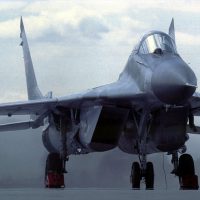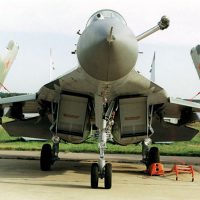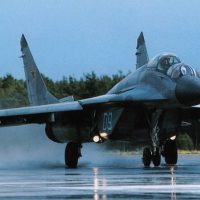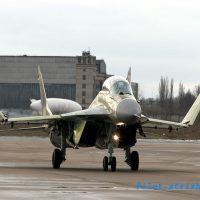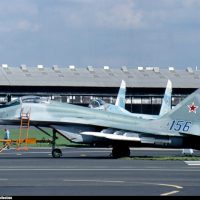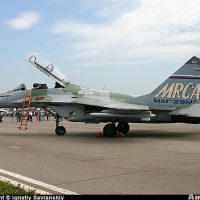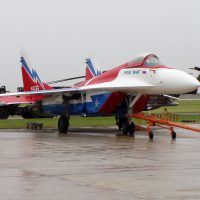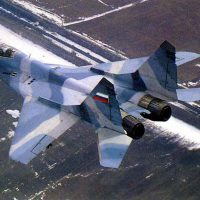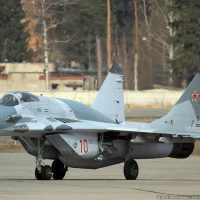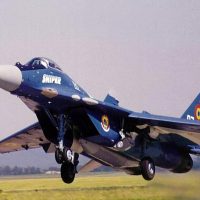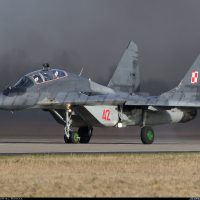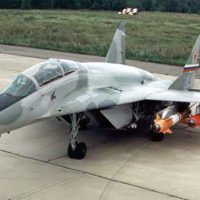Variants
- MiG-29 A
- MiG-29 K
- MiG-29 KU
- MiG-29 KUB
- MiG-29 M
- MiG-29 M2
- MiG-29 OVT
- MiG-29 S
- MiG-29 SMT
- MiG-29 Sniper
- MiG-29 UB
- MiG-29 UBT
Land-based single-seat counter-air tactical fiTcanghter, designed to operate primarily under ground control. Entered production at MMZ No. 30 in 1982. First production series aircraft (about 250) with anti-spin ventral fins (although these already deleted or removed from most prototypes). Some early aircraft also had ‘babochka’ (butterfly) gravel-deflector above, and in front of, nosewheels; soon deleted. First 30 aircraft featured composites inlet ducts, cowlings, leading-edge flaps control surfaces, spines and tailfins. D19 aluminium alloy intake ducts and flaps introduced from 31st aircraft for 20 kg (44 lb) weight penalty. Composites cowlings deleted later. Ventral fins removed on addition of BVP-30-26M chaff/flare dispensers which extend forward from fins on later ‘Fulcrum-As’. A-323 Shoran replaced A-312 Radikal NP Shoran on later 9.12s. Control surface deflection range increased and rudder chord extended by 21 per cent from 1984 for improved control at extreme angles of attack. Ailerons set at 5º up in the neutral position to improve spin characteristics. To meet air force requirements, dorsal fins extended forward to house chaff/flare dispensers, so extending keel area without impairing flight stability. Maximum weapon load 2,000 kg (4,409 lb). Some Russian aircraft had nuclear strike capability with 30 kT RN-40 bomb on reinforced port inner pylon. About 840 built by 1991.
Version lacking nuclear weapon delivery system, and with OEPrNK-29E electro-optical complex and downgraded IFF, for non-Soviet Warsaw Pact air forces. RLPK-29E (N-019E or N-019EA ‘Rubin’) radar may also have lacked two modes, giving total of only three. Produced between 1988 and 1991 for Bulgaria, Czechoslovakia, East Germany, Poland and Romania. Most modified to virtual 9.12B configuration (with removal of datalink and IFF) on break-up of USSR and Warsaw Pact. 9.12A/MiG-29A designation originally applied to unbuilt interim aircraft with S-23 radar, cancelled in 1976. (Prototype and preseries aircraft numbered 905 to 907 and 909 to 916.)
Downgraded version for non-Warsaw Pact export customers. Lacked Laszlo datalink. Built from 1986. Avionics include N-019EB radar, OEPrNK-29E2 EO complex, L006LM/101 RHAWS and further reduced-capability IFF and ECM. MiG-29 (DASA upgrade): Aircraft modified to allow operation within NATO air defence structure. MiG Aircraft Product Support GmbH founded 27 July 1993 as joint venture between Rosvooruzheniye, MAPO ‘MIG’ (now RSK ‘MiG’) and (then) Daimler-Benz Aerospace for D-level maintenance and modernisation of German MiG-29s. Western IFF, V/UHF, emergency radio, NATO standard units, Tacan and anti-collision lights installed first followed by GPS (on seven aircraft). These two modernisations ICAO I and ICAO II together form Level One. This followed by provision for underwing fuel tanks, extended airframe TBO (from 800 FH or 9 years to 1,300 FH or 15 years) and engine TBO and life (Level Two). Similar upgrade offered to other MiG-29 users, especially in Europe. Parallel upgrade, with Honeywell KLU-709 Tacan or surplus Luftwaffe AN/ARN-118 (instead of new AN/ARN-153), as well as ILS/VOR and Trimble 2101 I/O Plus GPS, R-865 VHF and new anti-collision lights, being applied to eight Polish MiG-29s (67, 70, 89, 105, 108, 111, 114 and 115) by WZL-2 depot at Bydgoscz, in association with MAPS joint venture. Polish upgraded aircraft have a new F-16A (ADF)-type SB-14 IFF antenna ahead of windscreen and received a new, darker two-tone grey camouflage. Remaining Polish aircraft will probably follow and MAPS has signed a teaming agreement for further work with WZL-2 in 1999, perhaps with further improvements, including ‘glass cockpit’. DASA signed MoUs with Bulgaria and Romania in October and November 1999 and opened negotiations with Hungary (including the Danubian Aircraft Company at Tököl) in May 2000. A contract for the upgrade of 14 MiG-29s was signed in August 2000 but was overtaken by a decision to lease F-16s in early 2001. Bulgaria’s MiG-29s will also receive a 1,100-hour/nine-year service life extension at the hands of DASA and TEREM, while DASA also has an agreement with Slovakia’s LOT. No customers have yet been found for DASA’s proposed Level Three upgrade (adding a MIL-STD-1553B databus, LINS/GPS and new IFF, navigation and communications systems) or for the planned Level Four, with a new radar, CDPU, and ECM. MiG-29 (EADS/Aerostar/Elbit ‘Sniper’ upgrade): Following an initial life extension programme on two MiG-29s and two MiG-29UBs, to Level Two standards, Aerostar has teamed with DASA to offer the Romanian Air Force a MiG-29 upgrade which would add most of the same avionics items as were applied to the air arm’s MiG-21s under the Lancer upgrade. This would build on the existing EADS NATO compatibility upgrade and life extension, and would use an avionics package supplied and integrated by Elbit, including a modular multirole mission computer linked to a MIL-STD-1553B digital databus, full HOTAS functionality, a second stripped-down Litton Italiana INS integrated with Trimble GPS and a new air data computer, a new Elop wide-angle HUD and two digital colour MFDs with a choice of metric or Imperial units, and with a new up-front controller. New Israeli Elisra SPS-20 RHAWS and compatibility with Western weapons. This upgrade may then be offered to other MiG-29 operators. The prototype (32367, donated by the Romanian Air Force) made its maiden flight on 5 May 2000, and was flown to Berlin for static display at ILA 2000, after completing a 15-flight test programme, on 26 May. Upgrade may be expanded to include an Elta EL/M-2032 pulse Doppler radar, as used by the Lancer-C. A decision by the Romanian Air Force is expected in 2002 or 2003.
First flown 4 May 1984; generally as ‘Fulcrum-A’, but introduced deeply curved top to fuselage aft of cockpit to house additional avionics, including L-203BE Gardeniya 1 FU active jammer; internal fuel capacity increased by 75 litres (20.0 US gallons; 17.0 Imp gallons); 1,500 litre (396 US gallon; 330 Imp gallon) underbelly fuel tank optional; weapons load increased to 3,200 kg (7,055 lb). Ammunition shellcase disposal modified to avoid centreline tank, allowing gun-firing with tank in place; auxiliary RWR/ECM antennas added to wingtips, and weapon control system improved. Three prototypes converted from standard ‘Batch 4’ MiG-29s; trials reportedly began April 1984. About 207 built from 1986 (beginning at serial number 05560). No ‘Fulcrum-C’ exports, although some were ‘inherited’ by independent republics on dissolution of USSR.
Multistage upgrade of type 9.13; initially with external load increased to 4,000 kg (8,818 lb) and with provision for two 1,150 litre (304 US gallon; 253 Imp gallon) underwing fuel tanks; these later added to some Russian 9.12s and 9.13s. Maximum fuel with external tanks is 8,240 litres (2,177 US gallons; 1,813 Imp gallons) for maximum range of 1,565 n miles (2,900 km; 1,802 miles). AoA operating range increased to 28º; RLPK-29M N019M radar, detection range 54 n miles (100 km; 62 miles) against fighter-size targets; now, with N019ME radar, able to track 10 targets and engage two simultaneously. Offered with third-phase improvements now associated with MiG-29SD, SE and N. Able to carry two pairs of R-27R1, R-27RE1, R-27T1 or R-27TE1 and two to six R-73E AAMs; up to six RVV-AE (R-77; AA-12 “Adder”) AAMs after radar upgrade, or up to 4,000 kg (8,820 lb) of bombs; two or four S-24B 240 mm rockets, two or four B-8M1 packs of 20 S-8 80 mm rockets, ZAB-500 napalm tanks or BKF cluster bombs, in addition to standard GSh-301 gun. Some features of trials aircraft first flown 5 May 1984; first true prototype flew 23 December 1990. Maximum T-O weight 19,700 kg (43,430 lb). Two regiments in former East Germany fully equipped with first phase aircraft before Russian withdrawal.
Current production version of MiG-29S for export; Phazotron NIIR N019ME Topaz radar; six RVV-AE (R-77; AA-12 “Adder”) AAMs; optional Western navigation, IFF and radio equipment and English language/Imperial units displays and instruments; downgraded L006LM/108 RHAWS; maximum T-O weight 20,000 kg (44,090 lb); performance data as for MiG-29S.
Current production upgrade of MiG-29S, with added ability to launch ASMs, including two Kh-29T/TE (AS-14 “Kedge”) or Kh-31A/P (AS-17 “Krypton”), or four KAB-500KR TV-guided bombs. First version to offer simultaneous dual-target engagement capability. Prototype/demonstrator 17941 first flown 1995, in which year it set C-1h records mentioned earlier. Maximum T-O weight 20,000 kg (44,090 lb). Future enhancements were to include radar with mapping mode. Overtaken by MiG-29SMT.
Export upgrade of basic MiG-29 (9.12), with most SE improvements, plus provision for ‘Dozaprahvka’ – inflight refuelling. Prototype (36034 `357′) began refuelling trials November 1995.
Advanced, genuinely multirole tactical fighter for control of upper airspace, ground attack and naval high-altitude precision weapons control; increased payload/range and endurance; intended as replacement for basic MiG-29. Preceded by 9.14 with Ryabina (mountain) LLTV targeting pod; 9.14 prototype (07682 “407”) first flew 13 February 1985, but became 9.13/MiG-29S development aircraft. Features greatly redesigned airframe; two 86.3 kN (19,400 lb st) Klimov RD-33K turbofans (“land-based” versions of MiG-29K engine); designed for triplex analogue fly-by-wire controls for lateral axis, quadruplex elsewhere, with mechanical back-up to ailerons and rudders (only pitch axis fly-by-wire by late 1996); “glass” cockpit with two monochrome (green) multifunction CRTs (not push-button, but HOTAS); modifications to extend aft centre of gravity limit for relaxed stability. First of six prototypes and one static test airframe flown 25 April 1986 with RD-33 engines; first flight with RD-33K engines (previously tested on 921) 26 September 1987; first exhibited at Machulishche airfield, February 1992; flight refuelling trials on standard MiG-29 test aircraft began 16 November 1995, completed January 1996; enlarged engine air intakes with movable lower lip to increase mass flow on take-off. Original FOD doors in air intakes replaced by lighter retractable grids, permitting deletion of overwing louvres and internal ducting in lightweight aluminium-lithium alloy centre-section, providing increased fuel tankage; new intakes tested on 921; total internal fuel capacity 5,700 litres (1,506 US gallons; 1,254 Imp gallons). New wing section, with sharp leading-edge. Increased span ailerons. Bulged wingtips with fore and aft RWRs; more rounded wingtip trailing-edge; larger, sharp-edge and slightly raised LERX; increased-chord horizontal tail surfaces, with dogtooth leading-edge. Bonded aluminium-lithium front fuselage, welded steel behind; nose lengthened by approximately 20 cm (7½ in); 40 mm (1½ in) higher canopy; new IFF and Gardeniya active jammer in dorsal spine, which terminates in “beaver-tail” structure, containing twin 13 m2 (140 sq ft) brake-chutes, that extends beyond jet nozzles; single larger honeycomb composite over-fuselage airbrake. Strengthened landing gear with KT-209 mainwheels. Extensive use of RAM giving claimed “×10” reduction in frontal RCS. Has 60 per cent lighter Phazotron NIIR N010 Zhuk (RLPK-29M) terrain-following and ground-mapping radar with 680 mm (26.77 in) dish antenna in larger diameter radome, able to track 10 targets and engage four simultaneously over a range of 43 n miles (80 km; 50 miles); (radar first flew in `Fulcrum-C’ “16”, Izdelie 9.16); new OLS-M longer-range IRST, with added TV channel and laser designator/marked target seeker using common mirror system. TS101 processors with new software. A-331 Shoran. Chaff/flare dispensers relocated in dorsal spine. Claimed more comfortable to fly, with increased permissible angle of attack (30º during initial tests, subsequently expanded), better manoeuvrability, improved cruise efficiency; eight underwing hardpoints for 4,500 kg (9,920 lb) stores, including four laser-guided Kh-25ML (AS-10 “Karen”) or Kh-29L (AS-14 “Kedge”), anti-radiation Kh-25MP (AS-12 “Kegler”) and Kh-31A/P (AS-17 “Krypton”) or TV-guided Kh-29T (AS-14 “Kedge”) ASMs; eight RVV-AE (R-77; AA-12 “Adder”) AAMs, R-73E (AA-11 “Archer”) AAMs or KAB-500KR 500 kg TV-guided bombs. Rounds for gun reduced to 100. Range on internal fuel 1,079 n miles (2,000 km; 1,242 miles), with three external tanks 1,726 n miles (3,200 km; 1,988 miles). Welded Al-Li structure very expensive and failed to provide promised weight savings. State Acceptamce Tests suspended due to funding problems, May 1993. Planned MiG-29UBM trainer (9.61) abandoned. Not ordered for Russian Air Forces at the time, though development was relaunched by MAPO in late 1999.
Export version of MiG-29M, with same weapons and equipment but with first-generation WCS based on N-019ME radar of MiG-29SD/SE. Redesignated MiG-33, but no longer being promoted.
New version, based on original 9.12/9.13 airframe, and incorporating many of the improvements and capability enhancements planned for the MiG-29M, originally including gridded intakes and still including the dorsal airbrake, but without that variant’s new lightweight Al-Li airframe. MiG-29SMTs can be produced on existing production jigs, or by retrofit of in-service aircraft, but the configuration is primarily a retrofit option. “Fifth generation” avionics system, based around MIL-STD-1553B equivalent databus, building on experience gained with Izdelie 9.21 (15125 “211”) which tested BTsK-29 digital avionics suite in 1987-88. Two 152 × 203 mm (6 × 8 in) MFI-68 colour LCD MFDs dominate panel, with multifunction control panels incorporating three smaller (96 × 77 mm; 3½ × 3 in) monochrome LCDs on side consoles. Digital moving map (and possibly Terprom-type elevation database and display) and upgraded HUD. Revised N019MP “Topaz” radar with synthetic aperture air-to-ground mode and larger “look” angle (70º in azimuth +50º/-40º in elevation). AoA limit to be raised to 30º. Last preproduction “Fulcrum-A” (925 “Blue 25”) rebuilt as avionics/cockpit mockup and displayed at Moscow Air Show, August 1997; MiG-29SD 05533 (“Blue 331”) rebuilt as avionics/cockpit prototype; first flew as such, 29 November 1997; modified with aerodynamic mockup of revised fuselage spine and flew again on 22 April 1998, having been renumbered “Blue 405”. The first full-standard 9.17 was a converted MiG-29S/9.12S demonstrator (35400 “Blue 917”) which first flew on 14 July 1998 with the new spine fully fitted, and including new fuel tanks. Revised spine with larger No 1 tank forward and new tank in rear part of fairing. Rear, “tail” tank protrudes beyond jetpipes and can be retrofitted at unit level. In combination, tanks give 1,475 kg (3,252 lb) (1,000 plus 475 kg; 2,205 plus 1,047 lb) increase in capacity, equivalent to 100 per cent increase in mission radius to 836 n miles (1,550 km; 963 miles) in the air superiority role, or 594 n miles (1,100 km; 683 miles) air-to-ground. Overall range increased to 1,889 n miles (3,500 km; 2,714 miles) or to 3,617 n miles (6,700 km; 4,163 miles) with a single aerial refuelling. Original scheme for SMT added outboard integral wing tanks, tanks in LERXes and in tailbooms, increasing capacity by 2,490 kg (5,490 lb) or 3,170 litres (337 US gallons; 697 Imp gallons). Aircraft also stated to be compatible with revised, enlarged, 1,800 litre (476 US gallon; 396 Imp gallon) underwing fuel tanks and with bolt-on retractable AAR probe. Warload increased to 5,000 kg (11,023 lb) in air-to-ground role. Installation planned of 98.1 kN (22,050 lb st) RD-43 (RD-333) engines, possibly later with thrust vectoring. MTOW raised to 21,000 kg (46,297 lb). Service life extended from 4,000 to 6,000 flying hours. Believed aimed primarily at Russian Air Forces as MLU for about 180 existing aircraft but offered for export, including to Ecuador. MIL-STD-1553B bus will simplify integration of Western displays, avionics and weapons. Original Russian plan was for up to 15 upgrades in 1998, building to 40 per year by 2000; however, first air force aircraft (01) completed on 29 December 1998 and demonstrated to customer at Zhukhovsky on 12 January 1999.
Further upgrades to the SMT are already planned or on offer, under provisional designation MiG-29SMT-II. Improvements include frontal RCS reduction measures, IR signature reduction and further increases in fuel tankage and warload. Fuel capacity to be increased to 5,600 kg (12,346 lb) through installation of new 219 litre (58.0 US gallon; 48.0 Imp gallon) tanks in LERX, replacing auxiliary air intakes and ducts, as in MiG-29M and original SMT scheme. Eight hardpoint wing (either based on MiG-29M, with broad span ailerons, or merely rebuilt standard wing) will allow warload increase to 5,500 kg (12,125 lb). Potential avionics improvements include new radar (N010, Zhuk, Zhuk PH or NIIR Zemchug). Some expect future MiG-29 variants to receive a new engine, the VK-10M, being developed by Klimov for production from 2010, with a thrust of 108 to 113 kN (24,250 to 23,350 lb st). Thrust vectoring may be offered. May use triple redundant digital FBW FCS developed for MiG-29M.
Carrierborne variant combining MiG-29SMT features with landing gear, carrier landing system, folding wing, double-slotted flaps, arrester hook and enlarged tailplane of MiG-29K. Believed to have been offered to India and China in association with initial efforts to sell carrier Admiral Gorshkov. Latter built to operate STOVL Yak-38, but modifications proposed for STOBAR (short take-off but arrested recovery) operation. Replaced by MiG-29K-2002 and MiG-29K-2008.
(K for korabelny; ship-based) Maritime version, used for ski-jump take-off and deck landing trials on carrier Admiral of the Fleet Kuznetsov (formerly Tbilisi), beginning 1 November 1989; two new-build prototypes, using MiG-29M structure; completely redesigned, mainly steel, wing using modified aerofoil section and of increased area (increased span, reduced leading-edge sweep) with double slotted flaps, drooping flaperons and more powerful leading-edge flaps; new spar in front of original wing box; new strengthened centre-section without overwing louvres (see MiG-29M); upward-folding outer wing panels; RD-33K turbofans with 92.2 kN (20,723 lb st) contingency rating for ski-jump take-offs. Fuel capacity reduced to 5,670 litres (1,498 US gallons; 1,247 Imp gallons). First flown (16188 “311”) 23 June 1988. (Preceded by MiG-29KVP, conversion of 07687 [preseries aircraft 918] with hook, strengthened landing gear and some carrier landing systems and used for trials at Saki from 1982.) Exhibited at Machulishche airfield, Minsk, February 1992, with typical anti-ship armament of four Kh-31A/P (AS-17 “Krypton”) ASMs and four R-73E (AA-11 “Archer”) AAMs. Production MiG-29K was intended to use same basic airframe, power plant, avionics and equipment as MiG-29M, with added wing folding, strengthened landing gear, ±90º nosewheel steering for deck-handling, arrester hook, fully retractable, permanently installed flight refuelling probe, and other naval requirements, including Uzel carrier beacon homing system, SN-K navigation suite with INS-84, Resistor Shoran/ILS, ACLS and new inertial platform and with radar upgraded to RLPK-29IM standards, giving better over-water performance. Ejection seat trajectory laterally inclined 30º so that a deck-level ejection would be into the sea, abeam the carrier, giving extra altitude for parachute to open.
Trainer derivative with two separate stepped cockpits remained unbuilt.
The original MiG-29SMTK (effectively a MiG-29SMT with the 9.31’s folding wing and landing gear), previously offered to India along with the former helicopter carrier Admiral Gorshkov, is understood to have been replaced by a new, multirole, carrierborne variant based more closely on the MiG-29K/M, albeit without the expensive Al-Li alloys. With a MIL-STD-1553B-type bus and open systems avionics architecture, the MiG-29K-2002 is compatible with a wide range of Russian and Western weapons, and may feature the colour displays and GPS-based navigation system of the MiG-29SMT. This variant, possibly designated MiG-29 MTK, is claimed to be able to perform 90 per cent of its missions with a 10 kt (18 km/h; 11 mph) wind-over-deck, even in tropical conditions using new autothrottle. One notable feature of the new aircraft is its much-reduced folded span of 5.80 m (19 ft 0¼ in), achieved by positioning the fold line much closer in to the wing-root, and by adding upward-folding tailplanes. The aircraft can also fold its radome (up and back), reducing overall length to 14.13 m (46 ft 4¼ in). Accordingly, Admiral Gorshkov can carry a full air wing of 24 MiG-29Ks (plus six helicopters), or (according to some sources) as many as 30.
upgrade configuration could add a computer upgrade and additional electro-optic, radar, IIR and recce pods, together with take-off performance improvements. In December 1999, it was reported that India had selected the MiG-29K for use aboard Admiral Gorshkov, and an initial order for 50 aircraft.
Revised carrier-borne two-seat trainer design offered to India, based on MiG-29K-2002 with reduced-span, inboard wing fold and folding tailplanes. Assumed to feature original stepped tandem cockpits of MiG-29KU.
Combat trainer; second K-36DM ejector seat forward of normal cockpit, under continuous canopy, with periscope and HUD repeater for rear occupant; no radar; gun, IRST sensor, laser range-finder and underwing stores pylons retained. Length 17.42 m (57 ft 2 in). Normal T-O weight 14,600 kg (32,187 lb); max speed 1,204 kt (2,230 km/h; 1,386 mph); service ceiling 17,500 m (57,420 ft). Prototype (with ventral fins) first flown 29 April 1981; production began 1982; 197 built by 1991. Phazotron and Sokol offering upgrade with new I-band slotted planar- or phased-array radar.Detailed description refers to “Fulcrum-C”.
Private venture programme funded by OKB, consisting of virtual SMT upgrade (increased fuel in enlarged spine, in-flight refuelling capability glass cockpit and enhanced avionics) for UB trainer. This transforms UB into operationally capable two-seat multirole fighter, with potential for Su-24 replacement or for “pathfinder” use. Expected to be fitted with a millimetre wave terrain-avoidance radar and Osa-2 X-band, phased-array centimetric air-to-air/air-to-ground radar, or with Thomson-CSF RC 400 radar in nose and missile launch and trajectory control system in wingroots. Full dual controls retained in rear cockpit, but augmented by large CRT display screen optimised for display of FLIR or video imagery; WSO would be a rated pilot who could take control if captain incapacitated. Long-serving demonstrator (08134 “304”) converted to UBT demonstrator/prototype making type’s Western debut at 1998 Farnborough Air Show, after only five test flights in new configuration, having first flown on 25 August 1998. First production conversion 25982 “952”, with folding refuelling probe, shown at Paris in June 1999. A further-upgraded aircraft, with four-pylon wings, refuelling probe and OSA-2, is expected to fly in mid-2000
MIG-29 version with 3-d thrust-vectoring nozzles. A fully representative prototype is due to fly by the year-end or early 2002. The nozzles installed on MIG-29OVT can move in any direction over the rear hemisphere at any range of engine operation, offering the aircraft astounding manoeuverability. Fire-control system including, Phazotron Zhuk-M radar and the full range of air-to-air and air-to-surface missiles, including the R-77 air-to-air missile and the KH-31 and KH-35 air-to-surface missiles.
The upgraded MiG-29 SNIPER was first demonstrated in Berlin- ILA 2000 and Timisoara Air Shows . The SNIPER maiden flight on 5th May 2000 demonstrated that the cooperation between Daimler Chrysler Aerospace (now EADS), AEROSTAR S.A. from Romania and ETBIT SYSTEM Ltd. from
Israel was completely fruitful. The Parties utilized an aircraft that is used in the Romanian Air Force, extended the aircraft life and upgraded it with enhanced avionics.
The new avionics includes:
- installation of a new modular multi role computer (MMRC)
- installation of a Mil-Bus 1553B
- upgraded western avionics
- communication system (new radio stations)
- navigation system (e.g. integrated LINS/GPS)
- identification system (transponder)
- displays (e.g.: MFCDs of 6”X8”, Head-Up Display)
- radar warning receiver
- new HOTAS (hands on throttle and stick) system
- new ADC (Air Data Computer)
While the upgraded aircraft complies with NATO/ICAO standards, the modified cockpit provides a modern Man-Machine Interface.
